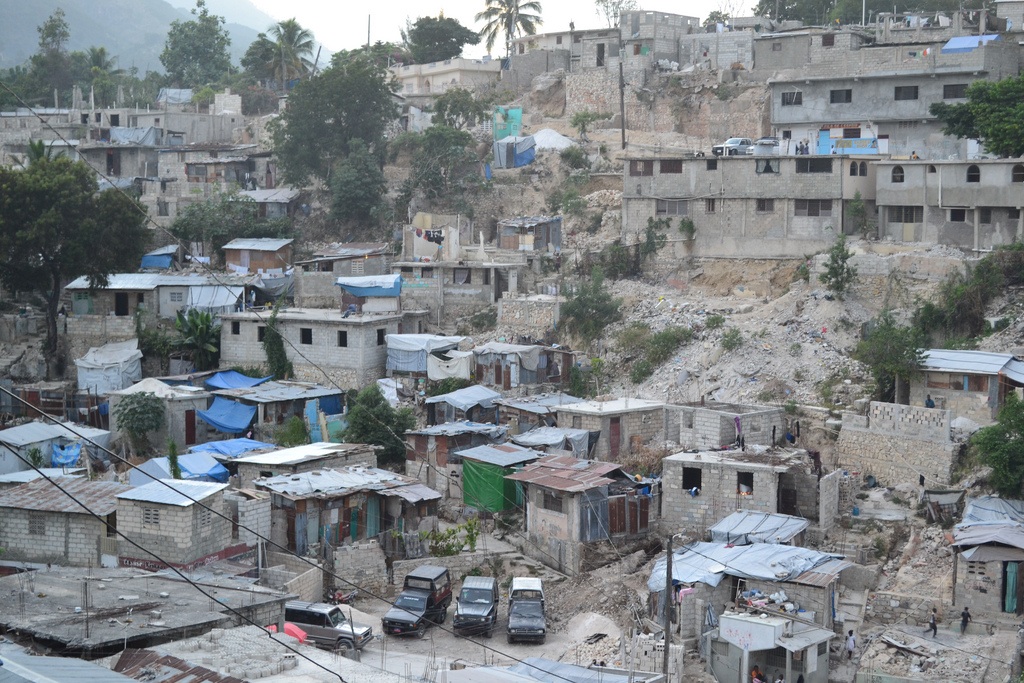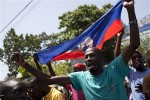Where the Devil Did the Reconstruction Money Go? | Mais où diable est passé l’argent de la reconstruction?
Editorial Comment
Earthquake-ravaged Haiti world’s biggest aid donor per capita
“Show me the money” articles about aid funds typically fail to capture my attention. Except for well-managed emergency aid, aid is generally harmful to a country because when handled dishonestly, aid money is corrupting and usually a euphemism for Swiss-bank account, and when handled honestly, aid money usually serves to undermine a country’s sovereignty.
The article below, however, is exceptional for its meticulous accounting detail and clear demonstration that the emergency aid funds for Haiti were used by the United States government mostly to pay itself and its connections. Should it surprise us that the United States paid itself to invade Haiti? Invasion is not aid. The U.S. was no more aiding Haiti than Napoleon had aided Europe. Large sums of aid money given to Haiti by the U.S. have mostly aided the U.S., since these funds were spent mainly on the U.S. army and other U.S. agencies and organizations.
In other words, Haiti was given the aid so it could give it back to the U.S. In fact, Haiti never actually saw the U.S. aid, which went from one U.S. pants pocket and into another. An alternative way to think about this story is to consider that earthquake-ravaged Haiti was forced to donate massive amounts of aid to the west — especially the U.S. — and has thus become the world’s biggest aid donor per capita.
Dady Chery, Editor
Haiti Chery
By Bill Quigley and Amber Ramanauskas
San Francisco Bay View | Courrier Internationale
English | French
Two years after the earthquake of January 2010, the country is far from being back on its feet. Might this be because it has barely glimpsed the color of the pledged aid? An investigation by the United States web site CounterPunch details in which pockets the amounts disbursed by Washington have gone.
In Haiti, it looks like the earthquake happened two months, instead of two years, ago. More than 500,000 people are still homeless and living in informal settlements, the ground is still littered with the debris of collapsed buildings, and cholera has been introduced in the country and turned into an epidemic that has already killed thousands of people and continues to touch thousands more.
The truth is that virtually no public donation has been sent directly to Haiti. Haitians have little or no control over the funds. But if we are to trust history, it is likely that they will be blamed for these failures – a little game called blame the victim.
Like many other people in the world, Haitians wonder where the money went. Here are seven places where the donations did or did not go.
1. The main beneficiary of the money donated by the U.S. after the earthquake proved to be the U.S. government. The same applies to donations from other countries.
Right after the earthquake, the U.S. allocated $379 million in aid and sent in 5,000 troops. The Associated Press discovered that of the $379 million in initial U.S. money promised for Haiti, most was not really money going directly, or in some cases even indirectly, to Haiti. They documented in January 2010 that:
- $125 million (33 percent) were actually given directly back to the U.S. to reimburse itself for sending in military troops.
- $150 million (42 percent) went to public and private non-governmental organizations (NGOs) like the U.N. World Food Program, the U.N. Pan American Health Organization (PAHO), and Save the Children.
The entire $1.6 billion allocated by the U.S. for emergency relief was spent in much the same way. According to an August 2010 report by the U.S. Congressional Research Office:
- $655 million (41 percent) went to reimburse the Department of Defense;
- $220 million (14) went to the Department of Health and Human Services to provide grants to individual U.S. states to cover services for Haitian evacuees;
- $350 million (22 percent) were allocated to the U.S. Agency for International Development (USAID) disaster assistance;
- $150 million (9.4 percent) went to the U.S. Department of Agriculture (USDA) for emergency food assistance;
- $15 million (0.94 percent) went to the Department of Homeland Security for immigration fees, and so on.
International assistance followed the same pattern. The U.N. Special Envoy for Haiti reported that of the $2.4 billion in humanitarian funding:
- $816 million (34 percent) were provided back to the donors’ own civil and military entities for disaster response,
- $672 million (28 percent) were given to U.N. agencies and non-governmental organizations (NGOs) for specific U.N. projects,
- $624 million (26 percent) were given to private contractors and other NGOs,
- $144 million (6 percent) were provided as in-kind services to recipients,
- $120 million (5 percent) went to the international and national Red Cross societies,
- $24 million (1 percent) were provided to the government of Haiti,
- $9.6 million (0.4 percent) of the funds went to Haitian NGOs.
2. Only 1 percent of the donations went the Haitian government
According to the Associated Press, for every dollar granted by the U.S. for emergency assistance, less than a penny reached the Haitian government. It’s the same with other international donors. The Haitian government was completely bypassed in the relief effort by the U.S. and the international community.
3. Ridiculously small sums went to Haitian businesses and NGOs
The Center for Economic and Policy Research, the best source of reliable information on this issue, analyzed all 1,490 contracts awarded by the U.S. government after the January 2010 earthquake until April 2011 and found that only 23 of those contracts went to Haitian companies.
Overall the U.S. had awarded $194 million to contractors,
- $4.8 million (about 2.5 percent of the total) went to the 23 Haitian companies.
- $76 million (or 39.4 percent of the total), on the other hand, went to contractors from the Washington, D.C. area.
As noted above, the U.N. documented that only 0.4 percent of the international aid went to Haitian NGOs.
In fact, Haitians had a hard time even getting into the international aid meetings. The NGO Refugees International reported that their local staff were having difficulty getting access to the operational meetings inside the U.N. compound.
“Haitian groups are either unaware of the meetings, do not have proper photo-ID passes for entry, or do not have the staff capacity to spend long hours at the compound.”
Others reported that most of these international aid coordination meetings were not even translated into Creole, the language spoken by the majority of Haitians!
4. A large percentage of the funds went to international aid agencies and big well-connected NGOs
- Over $486 million in donations for Haiti went to the American Red Cross.
The ARC says two-thirds of the money has been contracted to relief and recovery efforts, though specific details are difficult to come by. The CEO of ARC gets a salary of over $500,000 per year (390 000 euros, or 33 000 euros per month).
- An $8.6 million joint contract between USAID and the private company Cooperative Housing Foundation (CHF), responsible for removals of debris from Port-au-Prince, should also be noted.
CHF is a politically well-connected international development company with an annual budget of over $200 million and whose CEO was paid $451,813 [354,000 euros] in 2009. CHF’s connection to Republicans and Democrats is illustrated by its board secretary, Lauri Fitz-Pegado, a partner with the Livingston Group LLC, headed by former Republican speaker-designate for the 106th Congress, Bob Livingston, who does lobbying and government relations. Ms. Fitz-Pegado, who apparently works the other side of the aisle, was appointed by President Clinton to serve in the Department of Commerce; she served as a member of the foreign-policy expert adviser team on the Obama-for-president campaign.
According to Rolling Stone, CHF “works in Haiti out of two spacious mansions in Port-au-Prince and maintains a fleet of brand-new vehicles.”
The Rolling Stone, in an excellent article by Janet Reitman, reported on another earthquake contract,
- A $1.5 million contract to the New York-based consulting firm Dalberg Global Development Adviser
The article found that Dalberg’s team “had never lived overseas, didn’t have any disaster experience or background in urban planning… never carried out any program activities on the ground.…” and only one of them spoke French.
USAID reviewed their work and found that “it became clear that these people may not have even gotten out of their SUVs.”
On January 16, 2010, former U.S. Presidents George W. Bush and Bill Clinton announced a fundraising venture for Haiti. As of October 2011, the fund had received
- $54 million in donations.
Though most of the foundation’s work appears to be admirable, it has donated $2 million for the construction of a Haitian $29 million for-profit luxury hotel.
5. Some of the money went to for-profit companies that benefit from natural disasters
Less than a month after the quake hit, U.S. Ambassador to Haiti, Kenneth Merten, sent a cable titled “THE GOLD RUSH IS ON” as part of his situation report to Washington.
In this February 1, 2010, document, made public by The Nation, Haiti Liberte, and Wikileaks, Ambassador Merten reported that President of Haiti, Rene Preval, met with former Gen. Wesley Clark for a sales presentation for a Miami-based company that builds foam-core houses.
Capitalizing on the disaster, Lewis Lucke, a high-ranking USAID relief coordinator, met twice in his USAID capacity with Haitian Prime Minister Jean-Max Bellerive immediately after the quake. He then quit the agency and was hired for $30,000 a month by a Florida corporation, Ashbritt – already reputed for its big no-bid Katrina grants – and a prosperous Haitian partner to lobby for disaster contracts.
Lucke said,
“It became clear to us that if it was handled correctly, the earthquake represented as much an opportunity as it did a calamity.”
- Ashbritt and its Haitian partner were soon granted a $10 million no-bid contract.
- Lucke said he was instrumental in securing another $10 million contract from the World Bank and another smaller one from CHF International before their relationship ended.
6. A fair amount of the pledged money has never been actually delivered
The international community decided it would not allow the Haitian government to direct the relief and recovery funds and insisted that two institutions be set up to approve the projects and expenditures going to Haiti for the reconstruction. The first was the Interim Haiti Recovery Commission (IHRC, or Commission Interimaire pour la Reconstruction d’Haiti, CIRH) and the second was the Haiti Reconstruction Fund (HRF, or FRH).
At a conference in March 2010, U.N. member states pledged $5.3 billion over two years and a total of $9.9 billion over three years The money was to be deposited with the World Bank and distributed by the IHRC. The IHRC was co-chaired by Bill Clinton and the Haitian Prime Minister Jean-Max Bellerive. By July 2010, Bill Clinton reported that only 10 percent of the pledges had been delivered to the IHRC.
7. Much of the donated money is not yet spent
Nearly two years after the quake, less than 1 percent of the $ 412 million in U.S. funds specifically allocated for infrastructure reconstruction activities in Haiti had been spent by USAID and the U.S. State Department, and only 12 percent had even been obligated, according to a November 2011 report by the U.S. Government Accountability Office (GAO).
The performance of the two international commissions, the IHRC and the HRF, has also been poor. The Miami Herald noted that as of July 2011, of the $3.2 billion in projects approved by the IHRC, only five had been completed for a total of $84 million. The Interim Haiti Recovery Commission (IHRC), which has been severely criticized by Haitians and others since its inception, has been effectively suspended since its mandate ended at the end of October 2011. The Haiti Reconstruction Fund was set up to work in tandem with the IHRC, so while its partner is suspended, it is not clear how it can move forward.
What to do?
Instead of giving money to intermediaries, donations should be sent as much as possible to public and private Haitian organizations. Respect, transparency, and accountability are the building blocks of human rights.
Bill Quigley teaches at Loyola University New Orleans; he is the associate legal director at the Center for Constitutional Rights and volunteers with the Institute for Justice and Democracy in Haiti. He can be reached at: quigley77@gmail.com. Amber Ramanauskas is a lawyer and human rights researcher. She can be reached at gintarerama@gmail.com.
Sources: San Francisco Bay View (English) | Courrier Internationale (French) | Edited by Dady Chery, Haiti Chery | Detailed version of article with full sources available from authors
VIDEO: Interview between Live from Haiti and several Haitians, two years after the earthquake.
Bill Quigley et Amber Ramanauskas
Courrier Internationale
anglais | français
Deux ans après le séisme de janvier 2010, le pays est loin de s’être remis debout. Peut-être est-ce parce qu’il a à peine vu la couleur des dons promis ? L’enquête du site américain CounterPunch détaille dans quelles poches sont tombées les sommes versées par Washington.
En Haïti, on dirait que le tremblement de terre a eu lieu il y a deux mois, et non il y a deux ans. Plus de 500 000 personnes n’ont toujours pas de logement et vivent dans des camps informels ; le sol est encore jonché de tous les débris des bâtiments en ruine, et le choléra a été introduit dans le pays et s’est transformé en une épidémie meurtrière qui a déjà tué des milliers de personnes et continue d’en toucher des milliers d’autres.
La vérité, c’est que pratiquement aucun don du public n’a directement été envoyé en Haïti. Les Haïtiens n’ont à peu près aucun contrôle sur cet argent, mais si l’on en croit l’Histoire, il est probable qu’on leur reprochera ces échecs – un petit jeu appelé : “Accusons la victime”.
Comme beaucoup d’autres personnes dans le monde, les Haïtiens se demandent où est passé l’argent. Voilà sept endroits où les dons sont ou ne sont pas allés.
1) Le bénéficiaire principal de l’argent octroyé par les Etats-Unis après le tremblement de terre s’est révélé être le gouvernement des Etats-Unis. Il en va de même pour les donations des autres pays.
Juste après le séisme, les Etats-Unis ont consenti une aide de 379 millions de dollars et ont envoyé 5 000 soldats. L’agence américaine Associated Press a découvert en janvier 2010 que
- 125 millions de dollars (ou 33 centimes de chacun de ces dollars) avaient en fait été rendus directement aux Etats-Unis pour compenser le coût de l’envoi des troupes militaires.
- 150 millions de dollars (ou 42 centimes pour chaque dollar) ont été envoyé à des ONG publiques et privées comme Save the Children, le Programme alimentaire mondial des Nations Unies et l’Organisation Panaméricaine de la Santé (OPS) des Nations Unies.
L’ensemble du 1,6 milliard de dollars alloué par les Etats-Unis au secours d’urgence a été dépensé de la même façon :
- 655 millions de dollars ont servi à rembourser le département de la Défense,
- 220 millions ont été envoyés au département de la Santé et des Services à la personne pour qu’il aide les Etats américains à fournir des services aux réfugiés haïtiens,
- 350 millions ont été affectés à l’aide d’urgence fournie par l’Agence des Etats-Unis pour le développement international (Usaid),
- 150 millions sont partis au département de l’Agriculture pour participer à l’aide alimentaire d’urgence,
- 15 millions au département de la Sécurité intérieure pour couvrir les frais d’immigration, etc.
L’aide internationale a été répartie de la même façon. L’envoyé spécial des Nations unies pour Haïti a révélé que l’argent du fonds humanitaire, soit 2,4 milliards de dollars, avait été distribué de la façon suivante :
- 816 millions de dollars (ou 34 %) ont été renvoyés aux organismes civils et militaires des donateurs pour l’intervention d’urgence,
- 672 millions de dollars (ou 28 %) ont été attribués à des agences des Nations unies et à des ONG,
- 624 millions de dollars (ou 26 %) ont été alloués à des sociétés privées et à d’autres ONG,
- 120 millions de dollars (ou 5 %) ont été reversés à des sociétés nationales et internationales de la Croix-Rouge,
- 24 millions de dollars (ou 1 %) ont été versés au gouvernement haïtien et
- 9,6 millions de dollars (ou 0,4 %) ont été versés à des ONG haïtiennes.
2) Seulement 1 % des dons a été envoyé au gouvernement haïtien.
Selon l’agence Associated Press, sur chaque dollar accordé par les Etats-Unis pour l’aide d’urgence, moins d’un centime est parvenu au gouvernement haïtien. Il en va de même avec les autres donateurs internationaux. Le gouvernement haïtien n’a absolument pas été mis à contribution dans le cadre de l’intervention d’urgence menée par les Etats-Unis et la communauté internationale.
3) Des sommes dérisoires sont parvenues aux entreprises et aux ONG haïtiennes.
Le Center for Economic and Policy Research, la meilleure source d’information qui soit dans ce domaine, a analysé les 1 490 contrats attribués par le gouvernement américain entre janvier 2010 et avril 2011, et s’est rendu compte que seuls 23 d’entre eux avaient été accordés à des entreprises haïtiennes. Dans l’ensemble, les Etats-Unis ont distribué 194 millions de dollars à des sous-traitants, dont
- 4,8 millions seulement à des sociétés haïtiennes, soit environ 2,5 % du total.
- 76 millions de dollars, soit 39,4 % du total, aux sociétés privées de la région de Washington DC.
L’ONG Refugees International a indiqué que leurs collaborateurs sur place avaient eu du mal à accéder aux réunions opérationnelles organisées dans le complexe des Nations unies. D’autres ont noté que la plupart des réunions de coordination de l’aide internationale n’étaient même pas traduites en créole, langue que parlent la majorité des Haïtiens !
4) Un pourcentage non négligeable de l’argent a été transmis aux organismes internationaux d’assistance et aux grandes organisations non gouvernementales faisant partie de réseaux influents.
- 486 millions de dollars de dons pour Haïti ont été à la Croix-Rouge américaine.
Selon l’organisation, deux tiers de cet argent a servi à sous-traiter l’intervention d’urgence et la reconstruction, bien qu’il soit difficile d’obtenir plus de détails. Le salaire annuel du PDG de la Croix-Rouge est supérieur à 500 000 dollars par an [390 000 euros, soit 33 000 euros par mois].
- On peut aussi mentionner le contrat de 8,6 millions de dollars entre USAID et la société privée CHF, chargée de nettoyer les décombres dans Port-au-Prince.
CHF est une entreprise de développement international qui, politiquement, fait partie de réseaux influents, qui a un budget annuel de plus de 200 millions de dollars et dont le PDG a gagné 451 813 dollars [354 000 euros] en 2009. Les bureaux de CHF en Haïti “sont installés dans deux hôtels particuliers spacieux de Port-au-Prince et l’entreprise dispose d’une flotte de véhicules flambant neufs,” selon le magazine Rolling Stone.
- Rolling Stone a également révélé l’existence d’un autre contrat, d’une valeur de 1,5 million dollars, accordé au cabinet de conseil Dalberg Global Development Advisors, dont le siège est à New York.
Selon l’article, le personnel de Dalberg
“n’avait jamais vécu à l’étranger, n’avait aucune expérience en matière de catastrophe naturelle ou d’urbanisme, et n’avait jamais été responsable de programmes sur le terrain”,
et seul un membre de l’équipe parlait français.
Le 16 janvier 2010, George W. Bush et Bill Clinton ont annoncé le lancement d’une collecte de fonds pour Haïti. En octobre 2011, les dons avaient atteint la somme de 54 millions de dollars. Deux millions ont contribué à la construction d’un hôtel de luxe en Haïti, pour un budget total de 29 millions de dollars.
5) Une partie de l’argent a été versée à des entreprises qui profitent des catastrophes naturelles.
Lewis Lucke, un coordinateur haut placé d’USAID, a rencontré le Premier Ministre haïtien Jean-Max Bellerive deux fois à la suite du tremblement de terre. Il a ensuite démissionné et a été embauché – pour un salaire mensuel de 30 000 dollars – par la société Ashbritt, installée en Floride (déjà célèbre pour avoir obtenu des subventions considérables sans appel d’offres après l’ouragan Katrina) et par un partenaire haïtien prospère, afin de faire du lobbying pour obtenir des contrats. Lewis Lucke a déclaré qu’il était
“devenu évident que si la situation était gérée correctement le séisme pouvait apparaître comme une opportunité autant que comme une calamité”.
Ashbritt et son partenaire haïtien se sont rapidement vu attribuer un contrat de 10 millions de dollars sans appel d’offres.
6) Une partie non négligeable de l’argent promis n’a jamais été distribuée.
La communauté internationale a décidé de ne pas laisser le gouvernement haïtien gérer le fonds d’assistance et de relèvement et a insisté pour que deux institutions soient créées pour approuver les projets et les dépenses dédiées aux fonds de reconstruction envoyés pour Haïti : la Commission intérimaire pour la reconstruction d’Haïti (CIRH) et le Fonds pour la reconstruction d’Haïti.
En mars 2010, lors d’une conférence, les Etats membres de l’ONU se sont engagés à verser 5,3 milliards de dollars sur deux ans et un total de 9,9 milliards de dollars sur trois ans. En juillet 2010, seules 10 % des sommes promises avaient été versées à la CIRH.
7) Une grande partie de l’argent donné n’a pas encore été dépensée.
Près de deux ans après le tremblement de terre, moins de 1 % des 412 millions de dollars alloués par les Etats-Unis à la reconstruction d’infrastructures en Haïti ont été dépensés par USAID et le Département d’Etat américain, et seuls 12 % ont réellement été affectés, selon un rapport publié en novembre 2011 par le bureau américain chargé du contrôle des comptes (GAO).
La CIRH qui, depuis sa création, a été sévèrement critiquée par les Haïtiens, entre autres, est suspendue depuis la fin de son mandat, en octobre 2011. Le Fonds pour la reconstruction d’Haïti a été créé pour fonctionner en tandem avec la CIHR. Ainsi, tant que cette dernière est interrompue, le Fonds pourra difficilement poursuivre sa mission.
Que faire ?
Au lieu de donner de l’argent à des intermédiaires, les dons devraient être envoyés autant que possible aux organismes haïtiens publics et privés. Le respect, la transparence et l’obligation de rendre des comptes constituent les fondements des droits humains.
Origine: Courrier Internationale
VIDEO: Interview entre Live from Haiti et quelques Haitians, deux ans après le seisme.









Comments
Where the Devil Did the Reconstruction Money Go? | Mais où diable est passé l’argent de la reconstruction? — No Comments